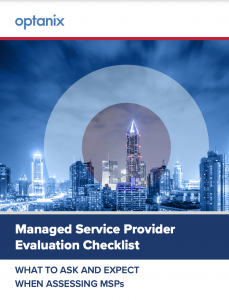
5 Managed Service Provider Best Practices Your MSP Should Follow
The best managed service providers are typically those that adhere to well-defined best practices. MSP best practices map directly to process maturity, so make sure you evaluate how process-driven an MSP is and understand the specific processes they follow before partnering with them. Excellent processes enable an MSP to support you in an efficient and consistent manner. This has bottom-line implications beyond meeting service-level agreements – it can ensure the viability, stability, and growth of your business.
What should you expect from your MSP?
This post provides an overview of the top managed service best practices that every MSP should be following. Leverage it when choosing an MSP for your organization to realize the full benefit of the MSP relationship.
 Need insight on evaluating a managed service provider for your organization? Download this MSP Evaluation Checklist to ensure you select the best partner.
Need insight on evaluating a managed service provider for your organization? Download this MSP Evaluation Checklist to ensure you select the best partner.
Managed Service Provider Best Practices
What makes a good managed service provider? Here are five key MSP best practices commonly followed by the best managed service providers:
- Following a well-defined IT service management (ITSM) methodology. Over the years, standardized frameworks such as ITIL have been proven to provide the procedural structure that delivers superior ITSM capabilities. This is a key indicator of the MSP’s operational capability.
- Providing comprehensive service descriptions. While this sounds basic, service descriptions provide a clear definition of the deliverables within the managed service offerings. MSPs that have service descriptions with clearly defined processes are more likely to deliver services in a reliable manner.
- Maintaining manufacturer certifications and specializations. Do the engineers hold and re-up their industry certifications? Does the MSP provide ongoing training to its staff? Are they investing in state-of-the-art technologies? Certifications ensure that the MSP has the ability to maintain the technologies they are using to provide services.
- Adhering to managed service provider security best practices. This goes beyond just cybersecurity and extends to the physical security around their NOCs and data centers. After all, you trust your data is safe with the MSP. Do they have a cybersecurity plan that is audited by independent third parties? Do they have processes in place to manage the physical security of their facilities?
- Having a comprehensive plan for continuity of operations. Ask if they have structured business continuity plans that are tested and updated on a regular basis. It doesn’t just have to be around disaster recovery or operational interruptions. As the recent COVID crisis has shown, it should also include response policies that cover pandemic-driven emergencies and other such events. Another factor is the physical nature of their NOC and data centers. What processes do they follow to maintain service delivery when one of these is impacted?
Managed Service Provider Responsibilities
Beyond best practices, there are a number of other attributes and MSP metrics you should consider when evaluating an MSP. First and foremost, you must make sure you fully understand what they consider managed service provider responsibilities and what they consider to be customer responsibilities. This will help you to avoid situations where you call on the MSP to resolve an issue or perform some other task only to be told it is not within the scope of your agreement.
Additionally, become familiar with their support policies and processes. MSPs with mature NOCs should be able to provide coverage both geographically and round-the-clock to respond to your support needs. In an era with increased remote working, this has a direct correlation with the productivity of your distributed workers and customers.
The Importance of MSP Best Practices
At the end of the day, MSP best practices are the key to building the confidence needed to reliably deliver business services. The best MSPs will go out of their way to do their best to manage and service your organization.
It’s up to you as a customer to ask your potential MSP the hard questions to determine which best practices they follow. Failing to do so adds to the overall risk of the day-to-day management of your business.